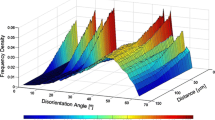Abstract
In this paper, we report an efficient segmentation and grain boundary detection process using modern image processing operators like simple linear iterative clustering and skeletonization. Accurate phase segmentation is the major requirement for any phase identification and quantification operations. The proposed image processing methods have been experimented on the in-house generated 48 scanning electron microscopy (SEM) microstructures obtained from plain carbon steel samples containing 0.1, 0.22, 0.35 and 0.48 wt%C and have been subjected to both annealing and normalizing treatments. The microstructures for dataset have been captured in SEM using secondary electron mode over a wide range of magnification × 500–× 5000. The experimental results significantly validate the segmentation of ferrite and pearlite regions. Also, the grain boundary detection results appear to be plausibly effective in case of ferrite–ferrite and ferrite–pearlite boundaries. However, the grain boundary detection efficiency is found to be relatively poor in case of pearlite–pearlite boundary. The overall performance of the proposed image processing technique in context of ferrite–pearlite steel SEM images shows promising results in all circumstances of compositional range, heat treatment and magnification.










Similar content being viewed by others
Data Availability
The raw/processed data required to reproduce these findings cannot be shared at this time as the data also form part of an ongoing study.
References
D.A. Linkens, Y.Y. Yang, M. Chen, M.F. Abbod, A comparative study of neural and fuzzy algorithms for prediction of properties in steel processing. IFAC Proc. 33, 283–288 (2017). https://doi.org/10.1016/s1474-6670(17)37007-6
P.J. García Nieto, E. García-Gonzalo, J.C. Álvarez Antón, V.M. González Suárez, R. Mayo Bayón, F. Mateos Martín, A comparison of several machine learning techniques for the centerline segregation prediction in continuous cast steel slabs and evaluation of its performance. J. Comput. Appl. Math. 330, 877–895 (2018). https://doi.org/10.1016/j.cam.2017.02.031
S. Krajewski, J. Nowacki, Dual-phase steels microstructure and properties consideration based on artificial intelligence techniques. Arch. Civ. Mech. Eng. 14, 278–286 (2014). https://doi.org/10.1016/j.acme.2013.10.002
S.J. Lee, J.P. Yun, G. Koo, S.W. Kim, End-to-end recognition of slab identification numbers using a deep convolutional neural network. Knowl. Based Syst. 132, 1–10 (2017). https://doi.org/10.1016/j.knosys.2017.06.017
B.L. DeCost, B. Lei, T. Francis, E.A. Holm, High throughput quantitative metallography for complex microstructures using deep learning: a case study in ultrahigh carbon steel. Microsc. Microanal. (2018). https://doi.org/10.1017/s1431927618015635
F. Zhang, A. Ruimi, D.P. Field, Phase identification of dual-phase (DP980) steels by electron backscatter diffraction and nanoindentation techniques. Microsc. Microanal. 22, 99–107 (2016). https://doi.org/10.1017/s1431927615015779
J.P. Papa, C.R. Pereira, V.H.C. De Albuquerque, C.C. Silva, A.X. Falcão, J.M.R.S. Tavares, Precipitates segmentation from scanning electron microscope images through machine learning techniques, in Lecture Notes Computer Science (LNCS) (Including Subseries Lecture Notes Artificial Intelligence and Lecture Notes Bioinformatics), vol. 6636 (2011), pp. 456–468. https://doi.org/10.1007/978-3-642-21073-0_40
J. Ling, M. Hutchinson, E. Antono, B. DeCost, E.A. Holm, B. Meredig, Building data-driven models with microstructural images: generalization and interpretability. Mater. Discov. 10, 19–28 (2017). https://doi.org/10.1016/j.md.2018.03.002
B.L. Decost, E.A. Holm, A computer vision approach for automated analysis and classification of microstructural image data. Comput. Mater. Sci. 110, 126–133 (2015). https://doi.org/10.1016/j.commatsci.2015.08.011
M.D. Hecht, B.A. Webler, Y.N. Picard, Digital image analysis to quantify carbide networks in ultrahigh carbon steels. Mater. Charact. 117, 134–143 (2016). https://doi.org/10.1016/j.matchar.2016.04.012
A. Chowdhury, E. Kautz, B. Yener, D. Lewis, Image driven machine learning methods for microstructure recognition. Comput. Mater. Sci. 123, 176–187 (2016). https://doi.org/10.1016/j.commatsci.2016.05.034
S. Banerjee, S.K. Ghosh, S. Datta, S.K. Saha, Segmentation of dual phase steel micrograph: an automated approach. Meas. J. Int. Meas. Confed. 46, 2435–2440 (2013). https://doi.org/10.1016/j.measurement.2013.04.057
G.F. Vander Voort, Metallography: Principles and Practice, Metallography (McGraw-Hill, New York, 1985). https://doi.org/10.1016/0026-0800(85)90051-5
R. Achanta, A. Shaji, K. Smith, A. Lucchi, P. Fua, S. Sabine, Slic 6(2011), 1–8 (2011)
E. Nhancement, A Comparative study of histogram equalization based image enhancement techniques for brightness preservation and contrast. Signal Image Process. Int. J. 4, 11–25 (2013)
N. Otsu, A threshold selection method from gray-level histograms. IEEE Trans. Syst. Man Cybern. 9(1), 62–66 (1979). https://doi.org/10.1109/TSMC.1979.4310076
R.K. Pandey, S.S. Mathurkar, A review on morphological filter and its implementation. Int. J. Sci. Res. 6, 69–72 (2017). https://doi.org/10.21275/art20163953
P. SrinivasaRao, M. Madhavi Latha, Generalized algorithm for two dimensional digital image skeletonization. Int. J. Comput. Appl. 95, 9–12 (2014). https://doi.org/10.5120/16565-6230
H.K.D.H. Bhadeshia, Physical metallurgy of steels, in Physical Metallurgy, 5th edn., ed. by D.E. Laughlin, K. Hono (Newnes, London, 2014). https://doi.org/10.1016/b978-0-444-53770-6.00021-6
R.W. Cahn, P. Haasen, Physical Metallurgy, vol. 1 (North-Holland, Amsterdam, 1996)
Author information
Authors and Affiliations
Corresponding author
Ethics declarations
Conflict of interest
The authors declare that they have no conflict of interest.
Additional information
Publisher's Note
Springer Nature remains neutral with regard to jurisdictional claims in published maps and institutional affiliations.
Rights and permissions
About this article
Cite this article
Gupta, S., Sarkar, J., Banerjee, A. et al. Grain Boundary Detection and Phase Segmentation of SEM Ferrite–Pearlite Microstructure Using SLIC and Skeletonization. J. Inst. Eng. India Ser. D 100, 203–210 (2019). https://doi.org/10.1007/s40033-019-00194-1
Received:
Accepted:
Published:
Issue Date:
DOI: https://doi.org/10.1007/s40033-019-00194-1




